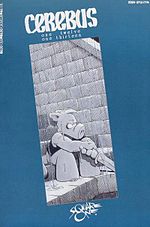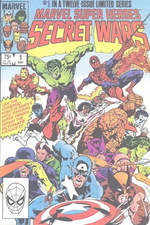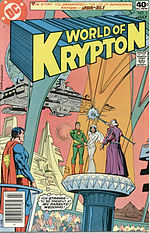- Limited series
-
A limited series is a comic book series with a set number of installments. A limited series differs from an ongoing series in that the number of issues is determined before production and it differs from a one shot in that it is composed of multiple issues.
The term is often used interchangeably with miniseries (mini-series) and maxiseries (maxi-series), usually depending on the length and number of issues. In Dark Horse Comics' definition of a limited series, "This term primarily applies to a connected series of individual comic books. A limited series refers to a comic book series with a clear beginning, middle and end." Dark Horse Comics and DC Comics refer to limited series of two to twelve issues as miniseries and series of thirteen issues or more as maxiseries, but other publishers alternate terms.
Contents
Characteristics
The limited series has a single story to tell. It follows the standard plot set-up of beginning, middle, and resolution. Usually, all plot points are covered by the end of the series. There have been limited series done in an anthology format, but only a few of these have been produced.
Limited series are often done by a single creative team, but in cases where there are changes, it is usually the writer who remains constant throughout the run while the artist(s) may change. The number of issues is usually determined by some combination of the writer’s plotting and editorial mandate.
History
The genesis of the limited series may be traced to anthology series and back-up stories in series featuring the title character. Publishers would often experiment with new characters and stories. If proven popular, these characters were quickly spun off to their own titles. This was a particularly common strategy of comics in the 1960s and 1970s, which saw a comics sales boom (many times, new titles were launched despite uncertainty about whether a character or team could carry a new series for more than a few issues).
Nowhere was this seen more than with DC Comics, which released many titles between 1975 and 1978, reaching close to 60 monthly ongoing titles. Eventually, DC was forced to scale back and cancel more than half of its titles (see the so-called DC Implosion). Aside from suffering financially, DC Comics was also criticized for straining itself creatively and editorially, affecting the quality of their comics.[citation needed]
Cerebus the Aardvark
 Cerebus the Aardvark #112/113 (July/August, 1988) published by Aardvark-Vanaheim. Cover art by Gerhard.
Cerebus the Aardvark #112/113 (July/August, 1988) published by Aardvark-Vanaheim. Cover art by Gerhard.
During 1979, 23-year-old Dave Sim had been a frequent user of marijuana, and soon began experimenting with LSD, taking the drug with such frequency that he was eventually hospitalized. Sim claims that it was this incident that led to the inspiration of creating to produce a comic book series called Cerebus the Aardvark, fixing the amount of issues to 300.
Sim did not realize at the time that by fixing the limit of issues, he had created a new format.[citation needed] As well as being the first limited series, it is also the longest limited series of all time, spanning 300 issues released from December, 1977 to March, 2004.
World of Krypton
In 1979, in the process of recovering from the DC Implosion, DC Comics decided to experiment with a new format to tell stories. The result was the 1979 World of Krypton miniseries,[1] as DC termed such short-run works. The new format allowed the company to tell stories that may not have fit into an ongoing series and to showcase characters into a short story without the risk and obligations of an ongoing monthly. It also freed creators to tell a longer story without the confines characteristic of a backup story.
Camelot 3000, Ronin
With the success of the miniseries format, DC Comics followed by experimenting with longer stories and concepts that were outside of their universe of superheroes. Debuting in 1982, Camelot 3000 was the first limited series to run to twelve issues and be dubbed as a "maxiseries."[2] Camelot 3000 was printed on Baxter paper stock and sold through direct market stores. DC followed Camelot 3000 in 1983 with another important contribution to the concept, Ronin, also printed on Baxter paper stock, with more pages than the conventional magazine pamphlet and featuring no advertisements.[3] Without the advertisements, it resulted in a different pacing in comics storytelling.
Marvel: Wolverine and Contest of Champions
 Marvel Super Heroes Secret Wars #1 (May 1984) published by Marvel Comics. Cover art by Mike Zeck.
Marvel Super Heroes Secret Wars #1 (May 1984) published by Marvel Comics. Cover art by Mike Zeck.
It did not take long for other publishers to follow the limited series form. Marvel Comics used it to feature popular characters from team titles and put them in a lengthy solo adventure. Wolverine's earliest solo adventures were told in limited series. Crossovers between two characters or teams presented as major storylines were also in limited series form before the concept of crossover stories jumping from one title to another was conceived. Contest of Champions brought forth the idea of a major event affecting the Marvel Universe. This would be taken further with the twelve-issue Secret Wars saga in 1984 and by DC’s Crisis on Infinite Earths in 1985.
The Dark Knight Returns
In 1986, DC released The Dark Knight Returns, the first mainstream comic printed on glossy paper stock utilizing the "prestige" (or "bookshelf") format, which was square-bound with a card-stock cover. The Prestige format is not favored by other publishers[citation needed] and DC Comics is the only publisher that continues to use it.
Dark Horse
The majority of Dark Horse’s comics are released in limited series form. Their contribution would be the idea of a series of limited series. Each limited series told a complete story to be followed by another one that built its story from the previous limited series. This provided an avenue for creator-owned works where the uncertainty of investing the creator’s property in an ongoing series was lifted from the creator’s concern. The owning creator could complete a limited series installment and follow it with another when they could. This was a model other publishers would use.
Since then, the limited series made it possible for creators to tell graphic novel-length stories. Releasing the story in monthly installments enabled them to immediately receive returns on investment. Further returns are possible with trade paperback collections of the series.
Lengths of limited series
Four-to-six issues is still the norm for most limited series, and presents the most reasonable investment for comic publishers, though there are series that run for as short as two or three issues. The twelve-issue maxiseries form was popular in the 1980s. Many memorable series ran this length, such as Secret Wars, Crisis on Infinite Earths, Watchmen, Amethyst, Princess of Gem World and Squadron Supreme. This form almost faded out in the 1990s. One point that went against it was the greater financial risk in investing in a lengthy limited series. The popularity of the maxiseries length was resurrected by DC with the success of Batman: The Long Halloween and The Kents.
Stories of greater length, those running to more than twelve chapters, were often done in multi-title crossovers, though the 1995 Marvel Comics event, Age of Apocalypse, involved several limited series that replaced the ongoing X-Men-related titles for four months and book-ended by two one-shot specials. This idea was revisited by Grant Morrison in 2005 with the Seven Soldiers of Victory project, and which he dubbed as a mega-series.[4] Marking the difference between the two, Age of Apocalypse was produced by several writers while the ambitious Seven Soldiers was the work of a single writer.
The DC project, 52, which ran from May 2006 to May 2007, became the largest limited series aside from Cerebus, composed of 52 weekly issues. DC did not label it as either a maxiseries or a miniseries, calling it simply a series (which is misleading since the project was always intended to end by the fifty-second issue). On 9 May 2007, DC immediately followed this series with another, similarly to be published weekly for 52 weeks, entitled DC Countdown. When DC Countdown was completed, DC launched another series in the same weekly year-long format, Trinity.
As a rule, the number of issues a limited series will run is determined from the outset. However, there have been cases where this rule was changed. There are usually only two reasons for this, one being commercial, the other being, to a rarer extent, creative. Dark Horse’s 1993 Aliens: Colonial Marines was originally supposed to run twelve issues. When the sales of Colonial Marines faltered midway through the run, the series was shortened to ten issues.[citation needed] Marvel’s Fantastic Four: Big Town was set to run six issues only to be set back to four issues. Number changing does not always result in reduction of issues. The first Gen¹³ was to run four issues, with the fourth a double-sized finale. Instead, the final issue was split to two in order to meet publishing schedules. Brian Michael Bendis found difficulty in resolving the finale of Ultimate Six and Marvel granted his request of extending the series from six to seven issues.[citation needed] The same thing happened with Marvel's Eternals Vol. 3, which went from six to seven issues when writer Neil Gaiman asked for an extra issue to resolve the ending. Most recently, the eight-issue X-Men First Class, as well as the six-issue Avengers: The Initiative, were both amended to become ongoing series instead, although with X-Men First Class the new books are officially considered as a second volume.
Occasionally, an ongoing series will be turned into a limited series. Marvel's The Ultimates began as a monthly series, but became a limited series when production issues arose.[citation needed] When Ultimates 2 was released, it too was released as a limited series. When Marvel's New Universe line of comics was cancelled completely, the final issues of the remaining three titles (Psi-Force, D.P. 7 and Justice (New Universe)) were labeled "#32 of a Thirty-two-Issue Limited Series", in the same style that Marvel used to mark limited series at the time. This was humorously repeated as Marvel, when ending its Transformers comic book in 1992 with issue #80, put a caption on the cover of the book claiming that it was "#80 in a four issue limited series".[citation needed]
Notable limited series
See also: List of limited seriesTitle Publisher Year Number of issues Comments Cerebus the Aardvark Aardvark-Vanaheim 1977 300 Creator Dave Sim had the idea of creating a 300 issue series (and make sure that this was the fixed number of issues). As well as being the first official limited series, it is also the longest limited series of all time (in terms of both number of issues and time span), spanning 300 issues released from December, 1977 to March, 2004. World of Krypton DC 1979 3 Originally scheduled for Showcase #104-106 to coincide with the premiere of Superman: The Movie. The storyline was rescheduled for Showcase #110-112, but by then Showcase had been cancelled. The Untold Legend of the Batman DC 1980 3 First miniseries created especially for the format. Tales of the Green Lantern Corps DC 1981 3 Secrets of the Legion of Super-Heroes DC 1981 3 Detailed the origins of each member of the Legion of Super-Heroes; revealed that R. J. Brande is Chameleon Boy's biological father Camelot 3000 DC 1982 12 First "maxi-series" Contest of Champions Marvel 1982 3 Marvel's first limited series Green Arrow DC 1983 4 Ronin DC 1983 6 Comics icon Frank Miller's first solo series. Secret Wars Marvel 1984 12 A major Marvel crossover series. Secret Wars II Marvel 1985 9 Arriving at about the same time, Secret Wars II and Crisis on Infinite Earths introduced the idea of limited series as company-wide crossover events. Crisis on Infinite Earths DC 1985 12 A pivotal series that re-shaped the entire DC Universe. Batman: The Dark Knight Returns DC 1986 4 First use of the "prestige format" Watchmen DC 1986 12 One of Alan Moore's highly praised comic limited series', recently adapted into a film. The series won the Eisner Award for "Best Finite Series" in 1988. The Shadow DC 1987 4 Hawkworld DC 1989 3 From Hell Kitchen Sink Press 1991 10 Bone Cartoon Books, Image Comics 1991 55 Sin City: The Hard Goodbye Dark Horse 1991 13 The first "yarn" of Frank Miller's iconic Sin City comic series, released in thirteen parts as part of the anthology comic book Dark Horse Presents. Hellboy: Seed of Destruction Dark Horse 1994 4 The first solo series for hit character Hellboy. Marvels Marvel 1994 4 Kurt Busiek and Alex Ross burst on the scene. The series won the Eisner Award for Best Limited Series in 1994. Kingdom Come DC 1996 4 The series won the Eisner Award for Best Limited Series in 1997. Marvel vs. DC Marvel/DC 1996 4 300 Dark Horse 1998 5 JLA/Avengers DC/Marvel 2003 4 Culmination of idea first hatched in 1979. Identity Crisis DC 2004 7 Infinite Crisis DC 2005 7 Marvel Zombies Marvel 2005 5 House of M Marvel 2005–2006 8 52 DC 2006–2007 52 Weekly series lasting for one year, with events detailed in real time. Follows Infinite Crisis. Civil War Marvel 2006–2007 7 Countdown to Final Crisis DC 2007–2008 51 Weekly series lasting one year, events detailed in real time. Titled "Countdown" for its first 19 issues. Numbered in reverse. Follows 52. The Umbrella Academy: Apocalypse Suite Dark Horse 2007 6 The series was written by singer Gerard Way of My Chemical Romance, who teamed up with critically acclaimed Brazilian comic artist Gabriel Bá. It also won the Eisner Award for "Best Limited Series" in 2008. Secret Invasion Marvel 2008 8 Blackest Night DC 2009 8 Brightest Day DC 2010-2011 24 The follow-up to Blackest Night. References
- ^ McAvennie, Michael; Dolan, Hannah, ed. (2010). "1970s". DC Comics Year By Year A Visual Chronicle. Dorling Kindersley. p. 181. ISBN 978-0-7566-6742-9. "The worldwide success of Superman: The Movie motivated [DC] to publish more Superman-related titles. With that, editor E. Nelson Bridwell oversaw a project that evolved into comics' first official limited series - World of Krypton...Featuring out-of-this-world artwork from Howard Chaykin, [Paul] Kupperberg's three-issue limited series explored Superman's homeworld."
- ^ GHM Columns : GHM Staff : Steve Higgins [ A+ Graphic Novels ]
- ^ The Continuity Pages: Frank Miller
- ^ SuicideGirls > Interviews > Grant Morrison
Notes
- Sequential Tart interview with Jenette Kahn
- GHM Online - Camelot 3000
- Dial B for Blog: Secret Origins of the DC Implosion
See also
Categories:- Comic book limited series
- Comics terminology
- Television terminology
Wikimedia Foundation. 2010.

